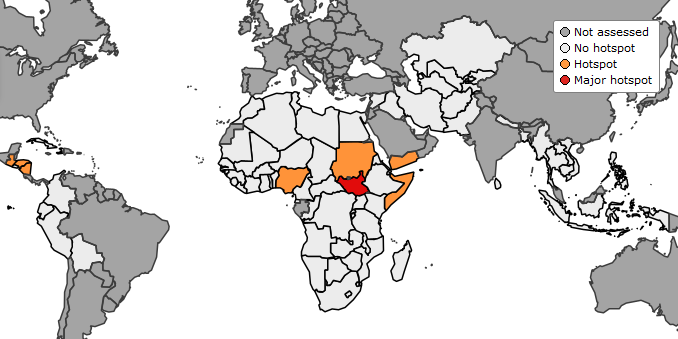
Dry conditions in North and East Africa, hurricane Iota brings destruction in Central America
© EU 2020
The November edition of the JRC's Anomaly Hotspots of Agricultural Production (ASAP) assessment is now available at:
Anomaly Hotspots of Agricultural Production (ASAP) assessment
Main findings of the November global overview:
- In Southern Africa, generally favourable weather conditions are benefiting early vegetative stages of summer cereal crops. Below-average biomass conditions are observed in southern Angola and southern Madagascar, and in pastoral areas of northern Namibia.
- In the bi-modal parts of East Africa, second season rainfall performance is mixed so far. In Sudan, although an average harvest is expected, a combination of factors is adding pressure to food security conditions. In South Sudan, food insecurity is pushed to emergency levels due to flooding, conflict and a worsening macroeconomy. Desert locusts continue to reproduce and spread in parts of the region (Red Sea coast; parts of Ethiopia, Somalia and north-west Kenya).
- In West Africa, the main season is complete and the production outlook is generally positive. Reduced outputs are expected in the conflict-affected parts of the region. Second season maize in the Gulf of Guinea is progressing well.
- In North Africa, a slow onset of the winter rainy season is observed, whereas in the Middle East rainfall arrived in November, supporting recently sown winter cereals. In Yemen, below-average yields are expected due to a combination of factors (conflict, COVID-19 restrictions, desert locusts and floods).
- In Central and South Asia, winter wheat has been sown under average rainfall conditions in November. Harvests of kharif crops, Aman rice and main season rice in Pakistan, Bangladesh and Nepal, respectively, are favourable. Plantings of main season rice in Sri Lanka have increased thanks to the arrival of the north-east monsoon in November.
- In South-East Asia, the wet season rice harvest has been completed, or is starting, with favourable prospects. However, there was damage to rice due to flooding and tropical storms in localised areas. Wet season rice in Indonesia has started under average rainfall conditions.
- In Central America, Hurricane Iota resulted in widespread flooding, particularly in Nicaragua, Honduras and Guatemala. Postrera season production is negatively impacted due to crop damage by torrential rains. Above-average production is anticipated in El Salvador.
The next assessment is scheduled for the end of January 2021.
Related Content
Anomaly Hotspots of Agricultural Production (ASAP) assessment
Details
- Publication date
- 1 December 2020
